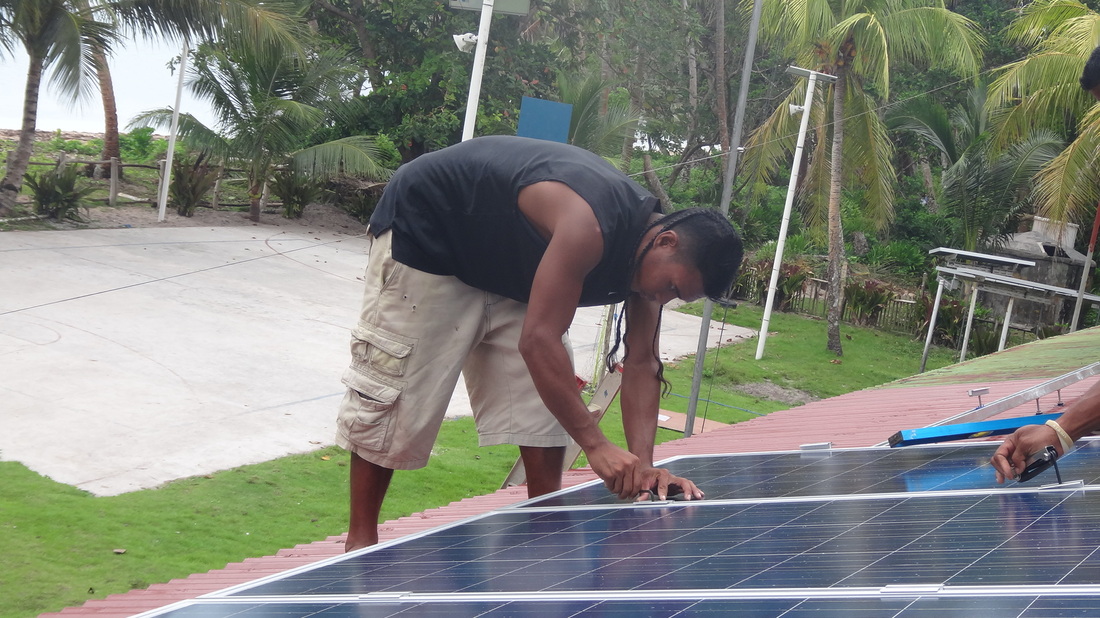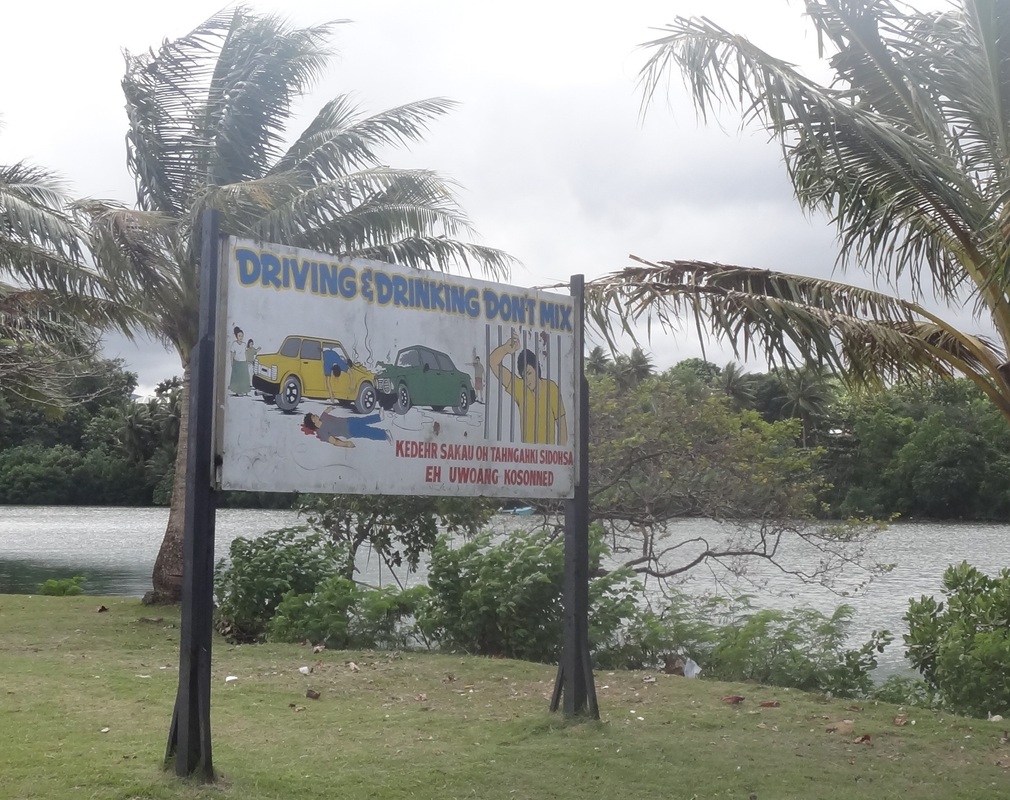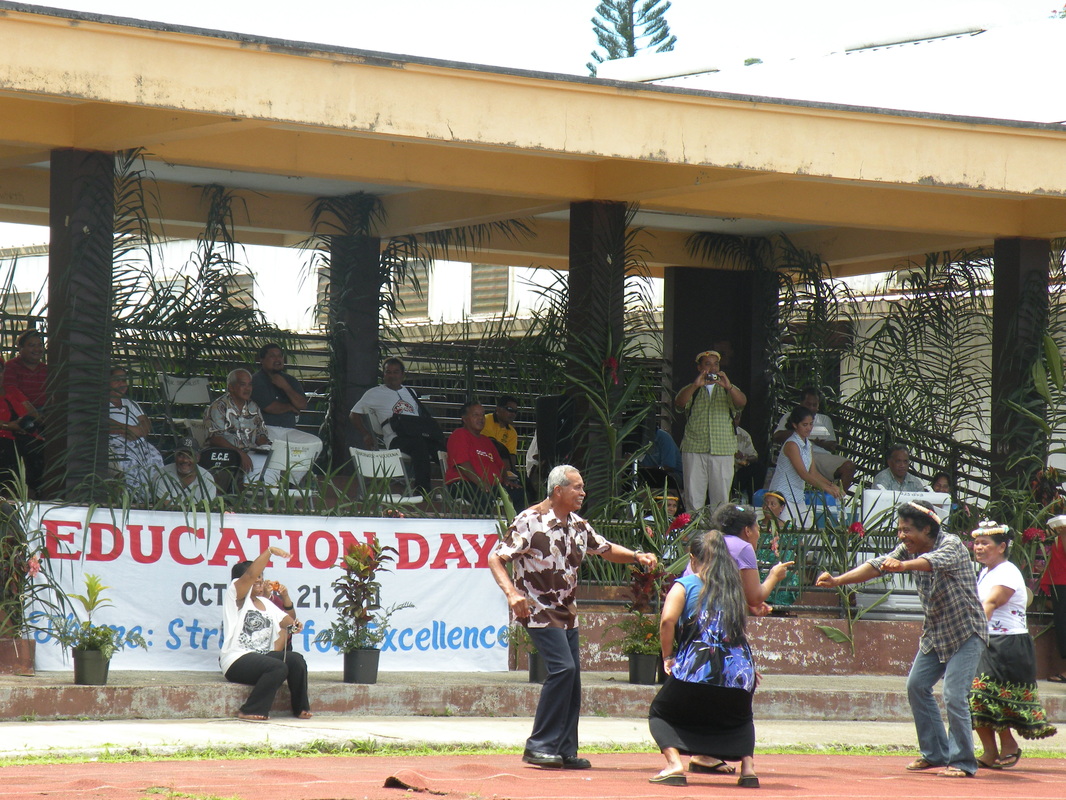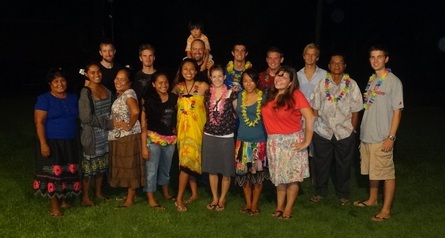 MAHI International and friends at the recent volunteer appreciation dinner _
I have been working on this post since I first arrived in Pohnpei. There were just so many things that were unique and distinct to Pohnpei that I started compiling a list. Every time I thought of posting it I would find something new and crazy, so I decided it was best to post it shortly before my departure.
I would like to say that if you ever plan on coming to Pohnpei, I'd recommend not reading this. Before I came I talked with my friend Alex who introduced me to Pohnpei. I tried to pick his brain to learn as much as I possibly could about this place and I consistently received vague answers. His response was essentially, "You just got to experience it for yourself man." While I might have been slightly frustrated at the time I'm very glad Alex allowed me to discover Pohnpei and all its idiosyncrasies on my own. Even if I did know all of this before I arrived though, I would still have to experience it. For example, I can tell you how there are crazy dogs all over the roads, but it’s entirely different when you have to walk home a mile at night in the pitch dark, navigating through all the dogs and beating off the aggressive ones with a stick.
That said, here’s a little taste of what makes Pohnpei, Pohnpei:
-Locals talk with their face. It’s very difficult to have a conversation with someone without having eye contact. I don’t think I’ve ever heard a local respond to a question with “yes.” Rather, they raise their eyebrows.
-Why did the chicken cross the road in Pohnpei?
a) It was being chased by a naked child with his fingers covered in Kool Aid
b) It was being chased by a pregnant dog
c) It was about to be run over by a beat-up pickup truck
d) It didn’t have a reason – chickens are incredibly stupid animals
e) All of the above
Correct answer: E, all of the above
-98% of all people wear zoris (i.e. flip flops) all the time. The other 2% is cowboy boots. (I'm not counting the few people who just go barefoot.) A trend among many Pohnpeians is the desire to be a cowboy. I find it very amusing every time I see Pohnpeians listening to country music.
 A teacher in one of our adopted schools rocking cowboy boots! -To show the size of something with your hands, you don’t hold your hands a certain distance apart. You put your hand on your arm for the distance of whatever object is from the tips of your fingers. So if you caught a fish a couple feet long, you would put your hand on your opposite arm a couple of feet.
-There is a Facebook epidemic here. Every time I walk into any place with computers, over 95% of the time Facebook is on the screen. The other 5% there’s some sort of computer game. Apparently, before they had Internet, solitaire was the king time drain.
-If Pohnpeians lived in New York City, many would be seriously injured if not killed. What I’m referring to is the Pohnpeian tendency to walk in the middle of the road without a care. Crossing the road? Take your time, what’s the rush? There are hardly any sidewalks anywhere and most roads are narrow as the jungle has creeped in on both sides.
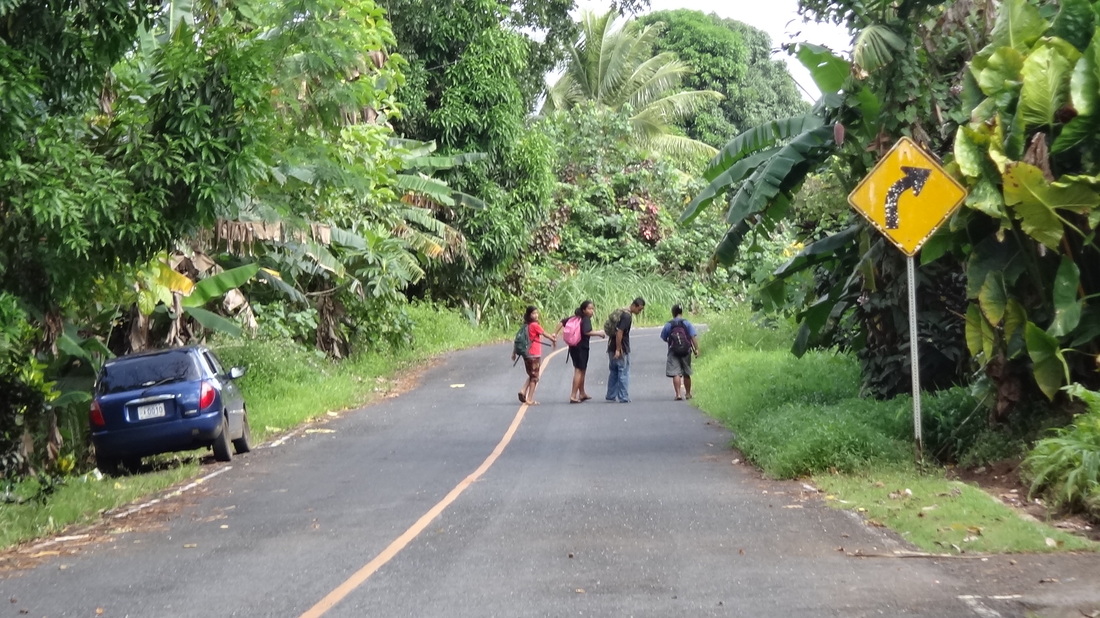 Students walking home using the local path, I mean road -If you ever come to Pohnpei, don’t be surprised or “weirded out” when the locals stare at you and continue staring after you make eye contact with them. First of all, you’re a “menwie” (men-why), i.e. a foreigner, so you don’t exactly fit in around here. Sometimes I feel like I should get that t-shirt that says “Keep Staring, I Might Do A Trick.” I got used to it pretty quickly though.
-You don’t need to iron clothes in Pohnpei. It’s so humid, no matter how wrinkled your clothes are, if you spray some water on them, the wrinkles will come out within 10 minutes or so.
-The multiple hairstyles here are awesome! Pohnpeians can rock the craziest hairstyles, I love it. I have multiple pictures to back up this claim, but here’s a couple:
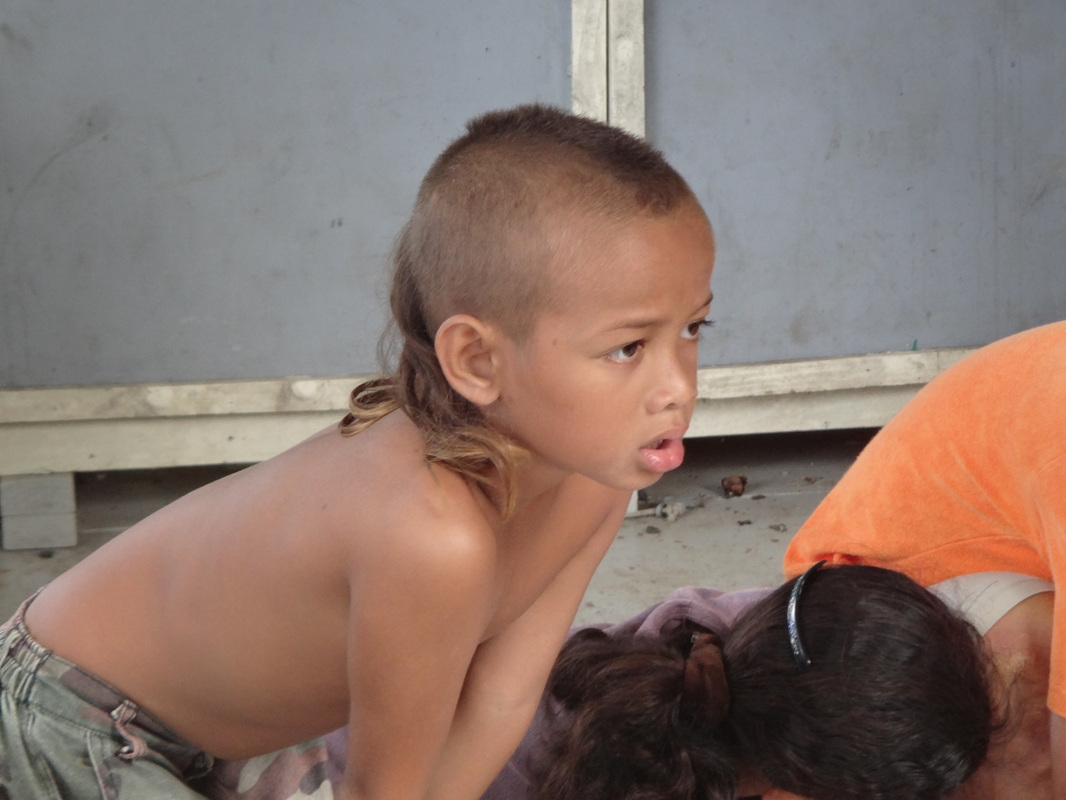 Slight mohawk with a mullet twist. Classic. _-It’s not unusual to see a male, at any age, taking a leak on the side of the road, at any time of the day. (Sorry, I don't have any pictures of this!)
-I’m willing to bet that around half of the cars on Pohnpei wouldn’t pass a general vehicle inspection in the States. Some cases are more obvious than others!
-Abandoned cars litter the roads all over the island. Most of the time these vehicles become part of the jungle environment as plants start growing in and around them. Occasionally, like in a picture below, the cars are taken away by a recycling facility here. In addition to cars, the Kolonia harbor is also littered with abandoned ships. All of it contributes to what makes Pohnpei, Pohnpei.
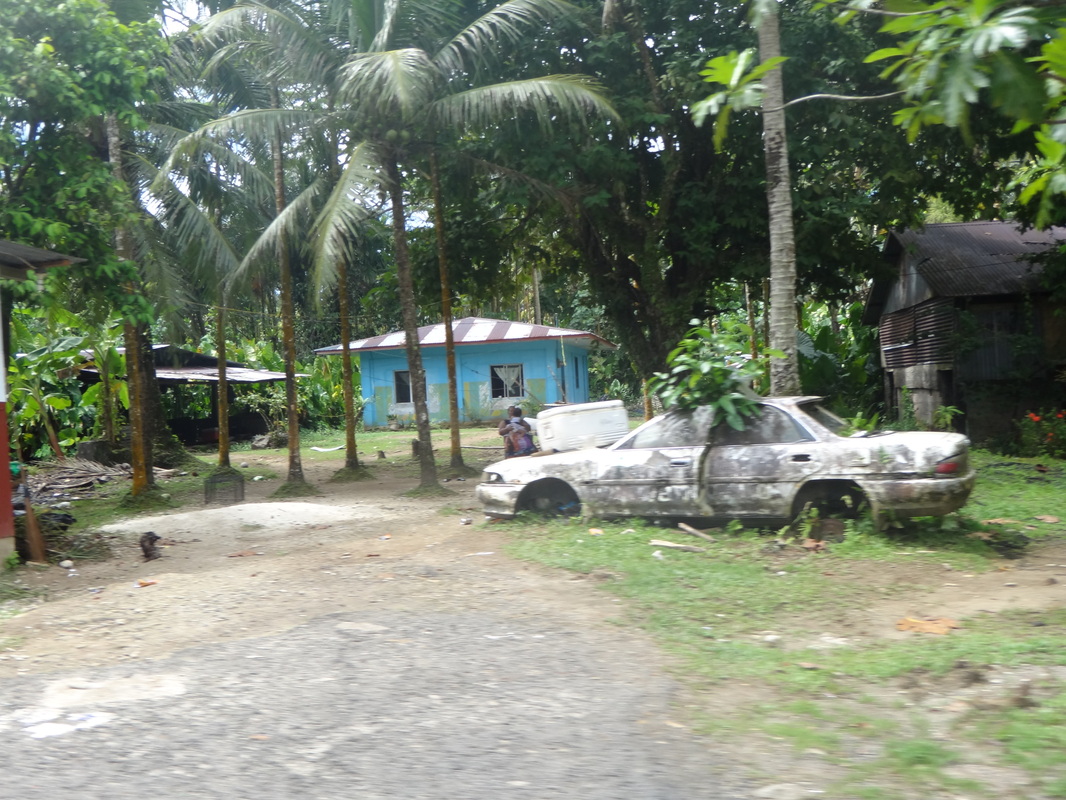 You can see a tree clearly growing directly in the car here! 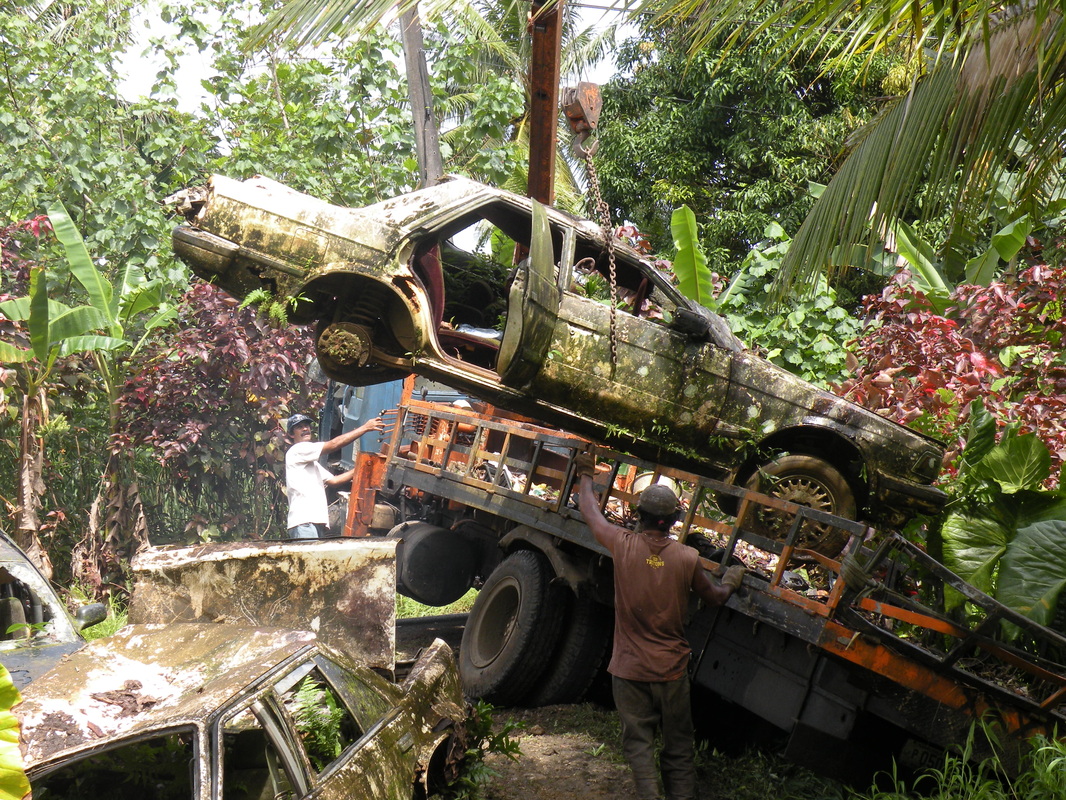 We had some cars moved that were close to our property - you don't see this every day! -It is perfectly acceptable and appropriate to spit at any place or time, regardless of age or gender.
-Occasionally when driving along the road you smell the strong odor of burnt hair. It’s rather gross. It’s actually not the smell of burning hair, it’s the cooking of turtle.
-Many guys wear female clothing and accessories, not knowing they’re associated as girly things. I’ve seen guys wear female rings, earrings and paint their nails. The funniest part is it’s usually the guys who are going for the “tough guy” image that make this mistake!
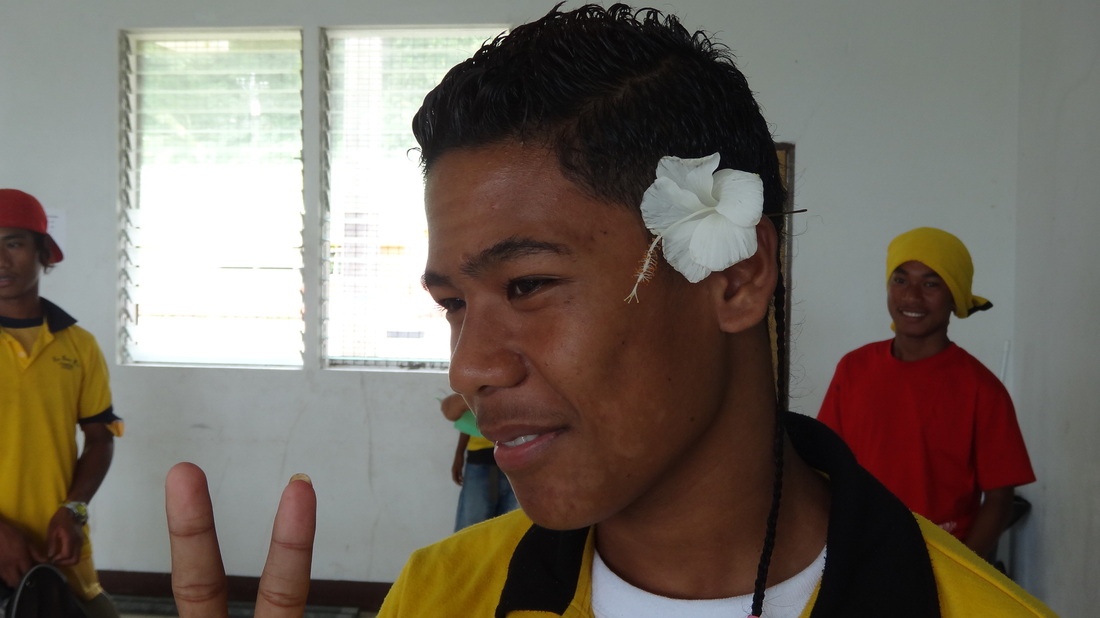 One of our students rocking the flower over the ear _-Every day on the road I see doors of moving cars open, whether passenger or driver (sometimes both at the same time!). The person then sticks his/her head out and spits a giant stream of red juice onto the road. These people are chewing betelnut – a local nut that is combined with lime and cigarettes. An extremely addictive habit, many locals are constantly chewing betelnut. As a result, the roads, parking lots and sidewalks are littered with red stains.
-The 100m world record will likely never be held by a Micronesian. The 100m while in flip flops world record, would most definitely be held by a Micronesian.
-You don’t go more than a couple hundred yards on any road in Pohnpei without seeing an animal. Literally, I’ve tested this. Most of the time its chickens, dogs and cats, but every now and then pigs, goats and ducks come out to play. 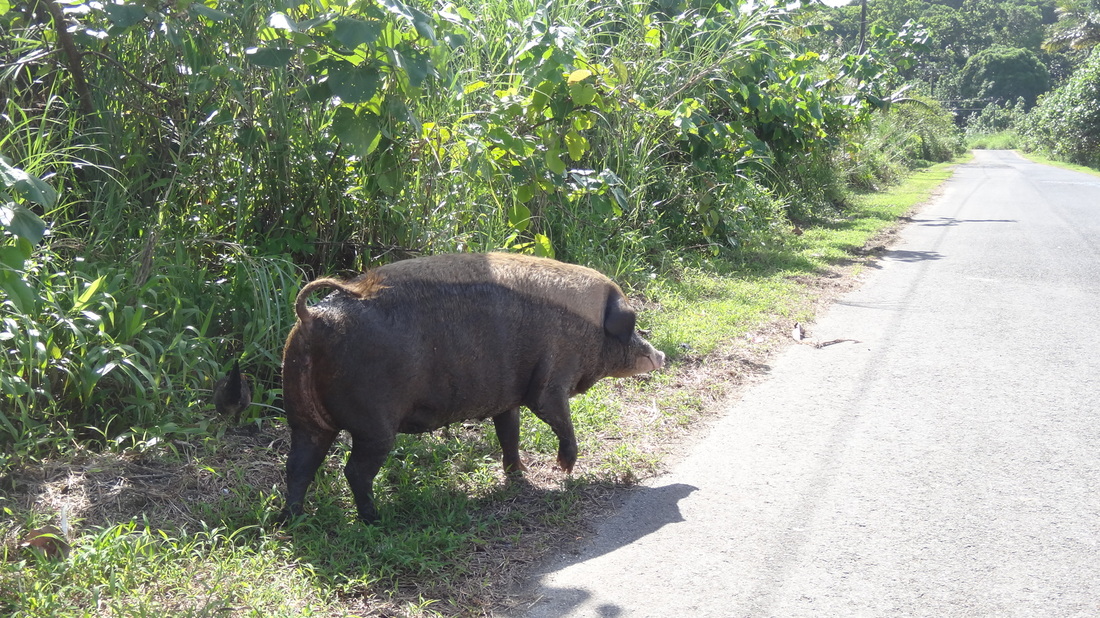 The most common animal found on the roads are dogs, but here's a rather large pig, along with a chicken in the brush to the left of the pig. _-Pohnpei has something that brings me back home to New Jersey – you can’t pump your own gas. The world really would be a better place with more Petroleum Distribution Engineers!
-When Micronesians get new appliances or electronics, they don’t take the plastic coverings off, ever. By keeping the plastic on a stove or printer for example, others think you have new things, which Micronesians find appealing.
-Why on earth many young Pohnpeians wear beanies is beyond me.
-While you drive on the right side of the road, cars are from both the US and Japan, so some cars have the steering wheel on the left, while others are on the right. I've driven cars with the steering wheel on the right and it takes a little bit of getting used to - everything is the opposite. I hope I didn't look too stupid when I put the windshield wipers on instead of the turn signal!
-Bob Barker would not be happy with this place.
-Many Pohnpeians have interpreted “backpack” to mean “chestpack,” wearing a backpack on the front instead of the back. It looks a little silly if you ask me.
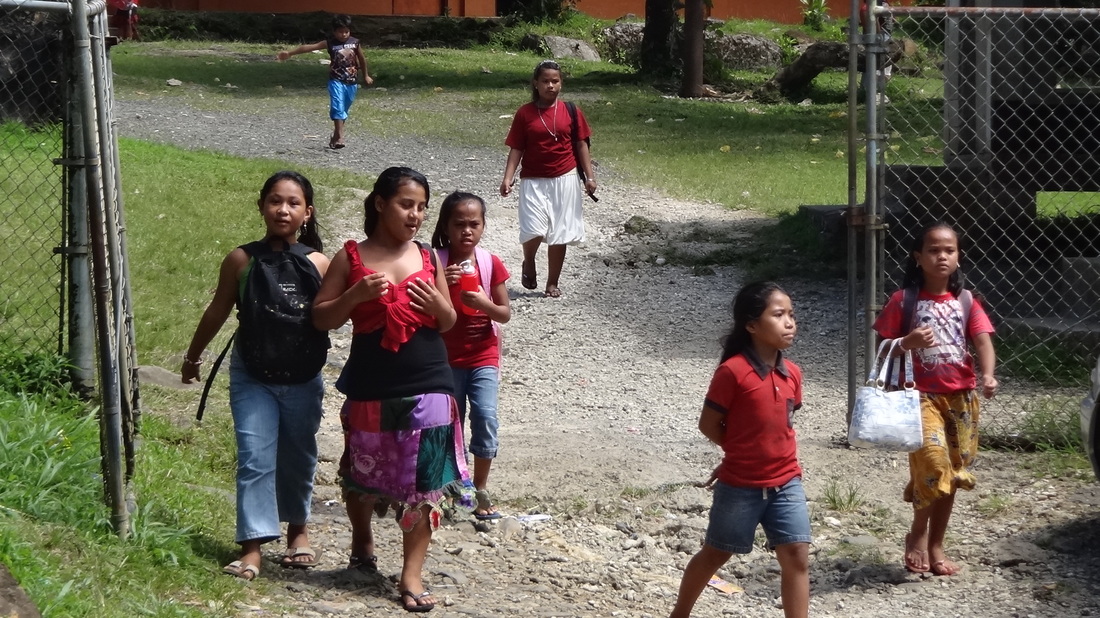 A girl rocking the chestpack on the left -Having to set the clock multiple times every day is just a normal part of Pohnpei life thanks to the frequent power outages.
-It’s not uncommon to come back to your car and people to be leaning or sitting on it. I always wondered what it would be like to bring some Micronesians to the US. If you’re caught leaning against someone’s car in the States you might get your head blown off.
-There is a high degree of copyright infringement here in Pohnpei. Here’s a short sample: Wall Mart, Cost Go, and South Park Hotel
-Despite being one of the rainiest places on earth, only on a handful of occasions have I ever seen a Pohnpeian carrying or using an umbrella. No matter how hard it’s raining there are always locals walking around like it’s a beautiful, sunny day.
-Speaking of rain, the phrase “when it rains, it pours” must have originated in Pohnpei. Hardly ever does it just drizzle in Pohnpei – most of the time it’s an absolute downpour.
-There's no limit to how many Pohnpeians can fit into the back of a pickup truck. It's hard to count when they drive by fast, but it's fair to say that I've seen pickups with at least ten people in the back.
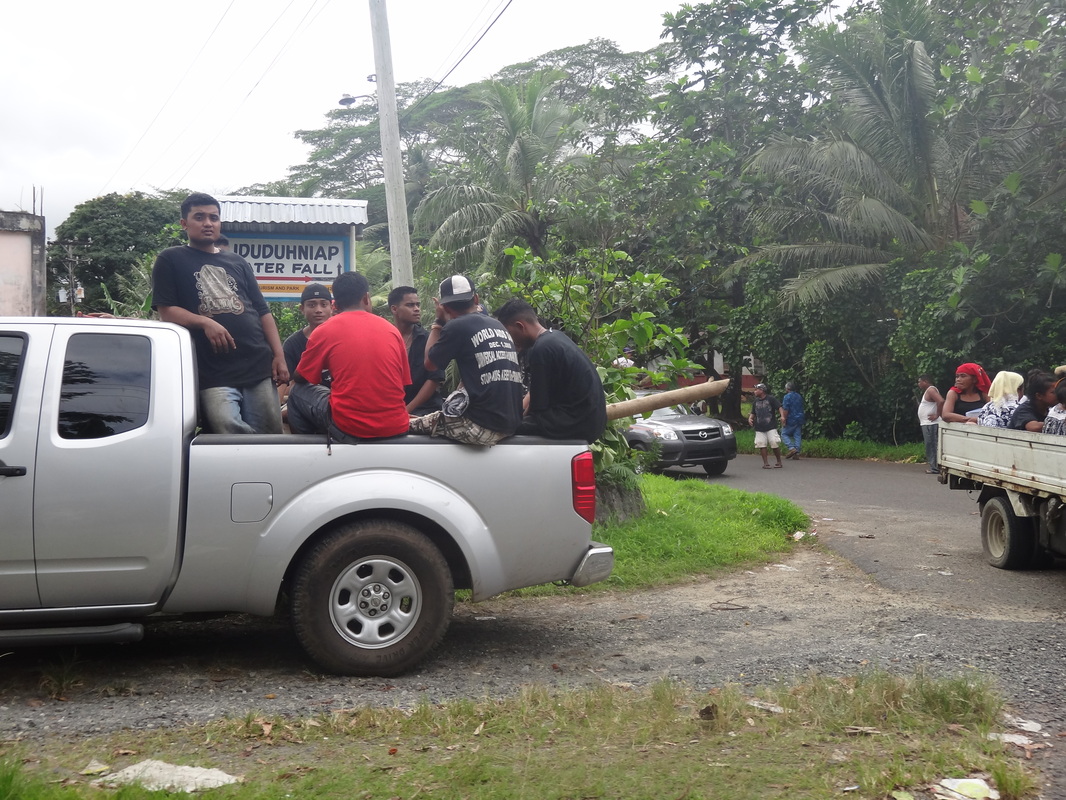 This is only a glimpse at how many people can fit in the back of a pickup. This truck has a big yam inside so that's taking up a lot of space. It's not fully shown, but the truck on the right is a more accurate representation of how many people can be squeezed into the small space. _-It’s not unusual to see two people walking down the street holding hands regardless of gender. If it is a male-female duo, they are not “together” – they are just friends or maybe brother/sister or cousins. The same goes for male-male or female-female. As a relatively conservative country it would be considered very inappropriate to publicly express solidarity in a homosexual relationship or even in a heterosexual relationship.
-Pohnpeian “billboards” aren’t exactly kid-friendly!
So there's my list. I'm sure if I stayed longer I would find new things to add to the list and I'm also sure there are plenty of other things those who have been in Pohnpei with me have noticed that I missed. But I hope this list gives you a slight taste of what makes Pohnpei such a crazy place - and I mean that in a good way! Below are some pictures that I have taken over the course of my service here that are just so incredibly random! I love walking out the door here and never knowing what I'm going to see. I'm going to miss that. Too much of the same is plain boring.
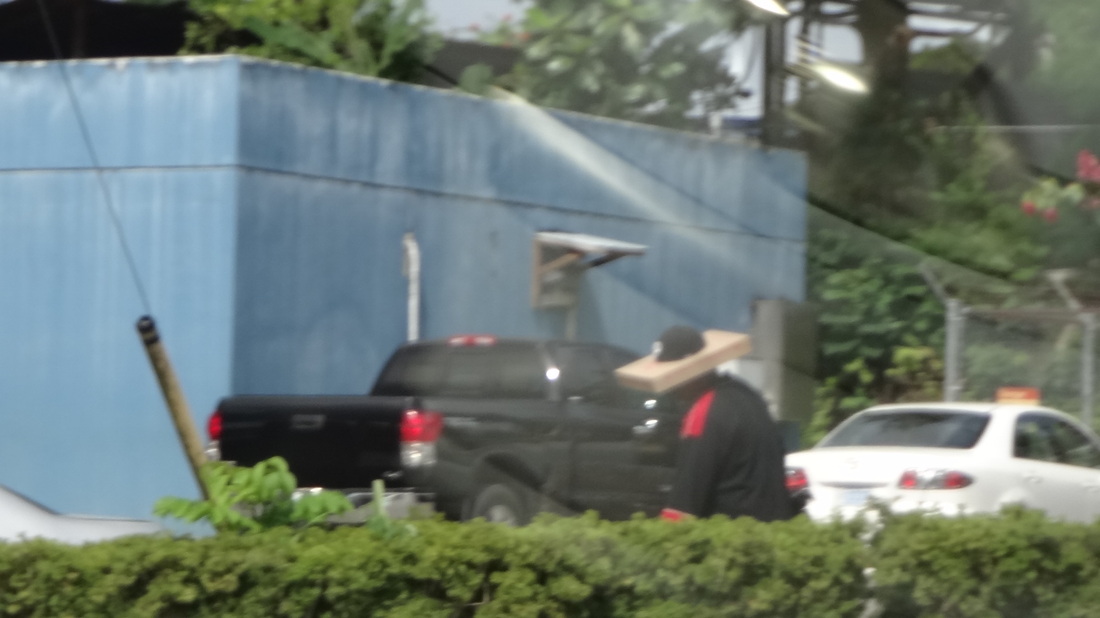 I call this the "Box Hat." This guy is trimming the bushes and found an innovative use for a pizza box to get some extra shade! 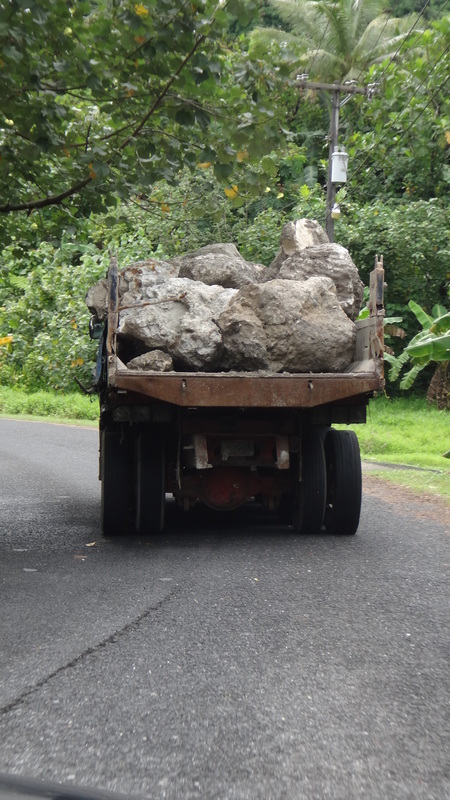 Mr. B and I were driving to Pohnlangas Elementary School and were stuck behind this truck for a good while. You can't tell from the picture, but a couple of those rocks were tipping whenever the truck hit a bump. This was just a little sketchy. If one of the rocks managed to roll out Mr. B and I would have been squashed. 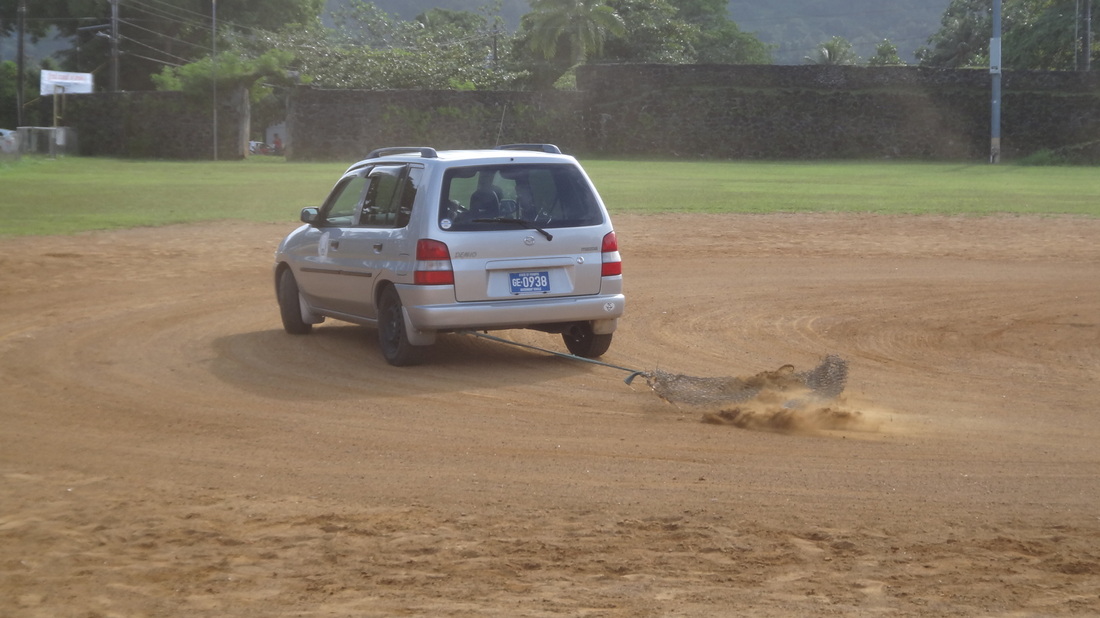 I LOVE this picture, and took it just the other day. I call this "Pohnpeian Groundskeeping." This is at the local softball field in downtown Kolonia. That is a government vehicle raking the field. Incredibly random, incredibly Pohnpeian! 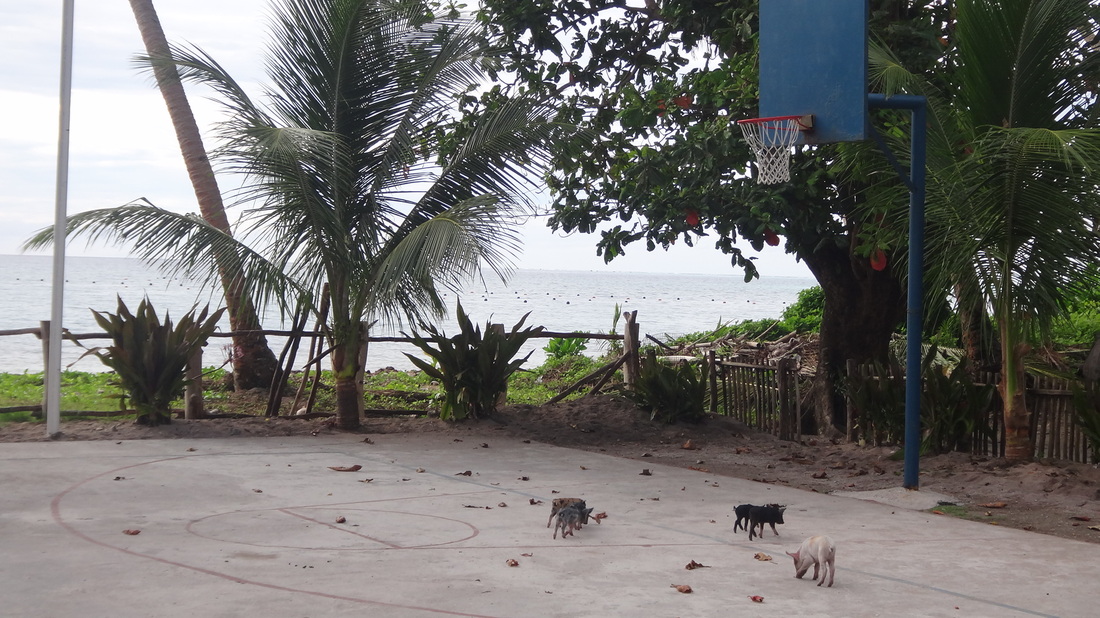 This is at Pakin, where I mentioned in my last post there are more pigs than people. Here are some piglets hanging out on the basketball court. This picture above says SO much. Here - read the story behind it.  Think you'd ever see this in the States? Here's a man outside a funeral walking with a leg of pig. An image that will forever remain in my head, that I failed to capture with my camera, is a ten-year old boy lugging a pig head on his shoulder. Crazy. 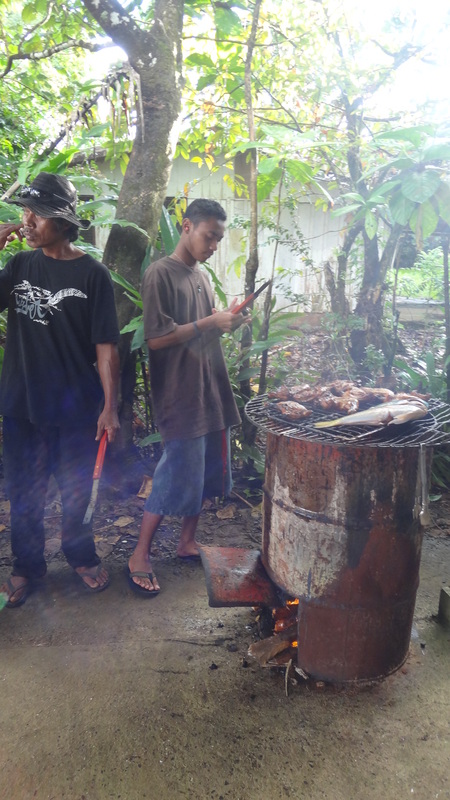 This is a Pohnpeian BBQ. It works very well. A cleaned-out 55 gallon drum with a little welding work to cut out a whole to feed the fire.  Colorful reef fish alongside chicken
It's hard to believe but I have less than a week left in Pohnpei. While I'm looking forward to seeing friends and family, I'm going to miss this place incredibly - in large part due to living in a place that is so unique, as evidenced by everything above. I'll leave the rest of these thoughts until my next post.
_ I thought a good post would be to take you through a normal day here in Pohnpei, detailing the work of the MAHI International Education Team. I then quickly realized that there is no such thing as a “normal” day here. This week was a prime example of the erratic Pohnpei schedule. We’re scheduled to go to our adopted schools on Monday, Tuesday and Thursday, with Wednesday and Friday acting as buffer days for inevitable schedule conflicts. If the schedule holds, my Wednesdays and Fridays are spent tutoring students who are really behind, researching and writing grants, and making the necessary preparations for our time in the schools. I also plan to work at the Department of Education to help assist in policy changes to improve the level of education provided throughout Pohnpei. With that information, let’s get into the week! Monday January 30 On Mondays we travel to Pohnlangas Elementary School, the largest and furthest school in our program. Mr. B and I usually leave Kolonia around 9:00 to arrive in time. I was informed early in the morning though that we wouldn’t be leaving until 10:30 as Mr. B had to attend a funeral. I wrote about funerals shortly after I arrived as a major part of Pohnpeian culture. When talking about the funeral dynamic in Pohnpei to friends and family back home, I often get the initial feedback of “Well, it’s a funeral, someone close to them died, of course it’s a big deal.” While this is true for those close to the individual that passed away, the funerals here are more of a large community event than a traditional American funeral. These funerals put families in debt for years and are a large impediment for progress on the island. How, for example, is a local to invest and start a business, if every time he saves up enough money he needs to spend it all, his entire savings, on a funeral? Mr. B wasn’t close to the person that died, but he is an influential member of his community and high-ranking in the traditional leadership on the island and needed to be there. He picked me up and we drove past the funeral. We were running early and stopped by for me to have the cultural experience of visiting a Pohnpeian funeral. My first reaction was being surprised at how many people were there. I haven’t been in groups larger than 20-30 people during my time here, so it felt very odd to be around 150-200 people. Certainly, I will experience reverse culture shock when I travel home! Beyond all the people, it was impressive to witness the massive amount of resources gathered there. I counted over 20 large Sakau plants (which are very difficult to grow) and over 15 pigs. As I have mentioned, pigs are a sign of wealth in Pohnpei and contributing a pig to a funeral is seen as a major sign of respect. Despite my perceived large size of the funeral, Mr. B said it was an average-small funeral. When a very influential member of the community dies the funerals can get truly massive - imagine 60-70 slaughtered pigs! For this funeral though, seeing all the enormous pigs cut in half and children playing with them was most definitely a unique cultural encounter. 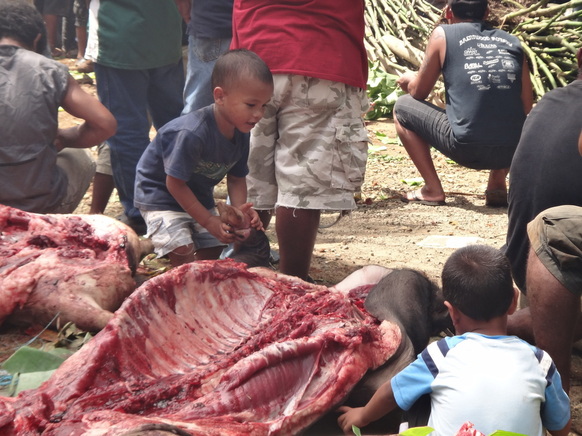 Children playing with a pig at a funeral We continued our drive to Pohnlangas, finishing our 70-minute drive and arriving before lunch was over. We normally teach six classes at Pohnlangas (two for each grade - 6th, 7th and 8th), but combined the classes in each grade to accommodate for our late arrival. I used the Hooked on Phonics program, reviewing the basic letter sounds I previously taught. I then took out the note cards we used to assess all our students during our reading level assessments in October and November. I went through each grade level, correcting mistakes and noting tendencies. I’ll elaborate on my found Pohnpeian tendency in my Tuesday notes (below)! After our three classes, we got back around 4:30 or so and I headed to tutor two children (ages 8 and 11) who recently arrived from Japan. Tuesday January 31 On Tuesdays we work in ESDM Elementary School in the morning and Sapwalap Elementary School in the afternoon. Both of these schools are located in the municipality of Madolenihmw (Med-ole-in-e-um), with ESDM being a 45-minute drive and Sapwalap almost an hour. The normal classroom I use at ESDM was occupied so I had to use the office and adapt to not having a chalkboard. Pen and paper wasn’t as good, but it did the trick. Mr. B and I stopped by a container store on our way to Sapwalap and picked up our normal lunch of nutrition biscuits. They’re nothing amazing, but they get the job done. When we remember/if we have time, we pick up some local food, like below _: 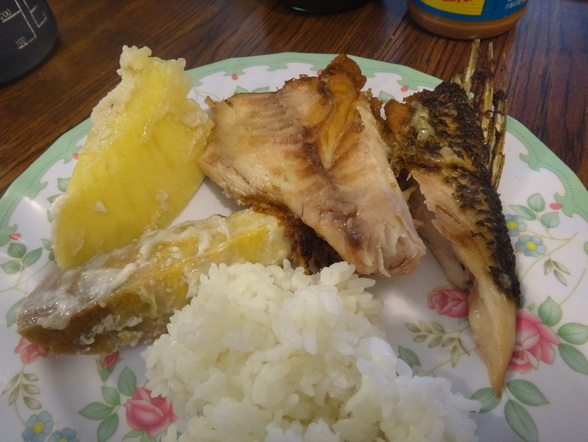 Clockwise: Fried Grouper (a type of reef fish), Rice, Taro, and Mahi (aka Breadfruit) I noticed on Monday in Pohnlangas a specific tendency most Pohnpeians have when speaking English. In fitting with the slow pace of everything on this island, Pohnpeians often speak too slow when pronouncing English words. Two of the most common words in Pohnpeian are spoken ridiculously slow. The word for hello is “Kaselehie” (casa-layyyyyyyyyyy-leeeeeeeee-ahhhhhhhhh). Culturally, the longer it takes to say the more respect you have for the individual(s) you’re addressing. This leads to it sometimes taking literally 5-seconds just to say "hello." The word for thank you is “Kalanghan” (ka-laaaaaaaaaaaaaan-guuun). This slow-speaking tendency translated directly to their speaking of English. When asking the students to say “Certainly” every time they said “sir-taaaaaaaiiinnnnnn-leeee.” Can you see the similarity to “Kalanghan” (ka-laaaaaaaaaaaaaan-guuun)? The students got a kick out of me speaking their Pohnpeian words, but I think they understood how English words are generally spoken more succinctly. Whenever possible, I try to apply whatever I’m teaching to something the students can relate to from what I know about Pohnpei.
Also, I had fun at the schools this week teaching them what "cadence" means. I explained how it's the rhythm in which you speak. I had them drum on tables to understand what rhythm means, and played some rap music (clean rap music, I must note) for them to get an idea of what it means to speak with rhythm and confidence.
Wednesday February 1
It’s February? What? Where did January go? I’m sure I wasn’t the only person that thought this, though being 16 hours ahead of Eastern Standard Time, I likely thought it before you! This week we were still figuring out how I would be using my new-found two “free” days during the week. I spent a large part of the morning researching new ESL teaching methods. I tutored my two Japanese children earlier in the day and spent the rest of the day researching. I expect having a day in the middle of the week away from the schools will be helpful in seeing the greater picture of the issues present in the schools and how we can help. Unrelated to my work was the needed pick-me-up. One of the things I miss most about home is watching sports. As an avid Chris Paul fan, and therefore a new Clippers fan, I likely accounted for at least 20 hits of this epic Blake Griffin dunk:
_ Thursday February 2
On Thursdays we travel to Sekere Elementary School and Sokehs Pah Elementary School (also known as RSP). Both of these schools are in the municipality of Sokehs and are the closest schools, being only 15-20 minutes away. When Mr. B and I arrived at Sekere we found the school completely deserted, save a few kids playing basketball. We asked them if there was school and were informed that there was a teachers meeting all day for all the schools on the island. This is typical Pohnpei - a random teachers meeting in the middle of the week and school being canceled. I guarantee you these students don’t have the US required 180 school days a year. I honestly would be surprised if it was close to 130. We made the plan to do our Sokehs schools the next day.
It really is frustrating to have setbacks like this. I often wonder aloud if we can ever really make an impact in this place, given all the constant obstacles. Despite the frustrations, I took the opportunity to visit the Seventh-Day Adventist School to see my friend Katie, who teaches a student MAHI International mentors. We arranged for me to work with him after school on my two “off” days. I also hoped to obtain more mp3 files the school has on the computer for the rest of the Hooked on Phonics program. The Hooked on Phonics sets that were donated to MAHI International are from 1998 and have the ancient technology of a cassette. I was unable to get the mp3s on Thursday, but made arrangements to get them this coming week. The rest of the day entailed more ESL and grant research and tutoring. Not an expected day, but as you might have gathered, there is no such thing as an “expected” day here.
Friday February 3
I called our Sokehs schools early in the morning to inquire if we could teach that day. I’m told by one principal that many teachers are absent, being sick or attending a funeral. He thought it would be best if we didn’t teach because he wanted the teachers to be there. The other principal said yes (technically, he said "eeeeeeeyyyyy mein" - Pohnpeian for Yes, with the "mein" being for respect, similar to "usted" in Spanish) and we taught there in the afternoon. I spent the morning traveling around with John to various appointments. There are plenty of stories from my time tagging along with John, but I’ll leave those for another time. After teaching in the afternoon I tutored again, where it was nice to evaluate the two children and see their progress from the two weeks I have been working with them.
As you can see, there is no script for a normal Pohnpeian day, or week for that matter. When I woke up Monday I had no idea I would be attending a Pohnpeian funeral, standing in the scorching sun, smelling the sweat of the large group and recently butchered pigs. I didn't plan to use rap music to help teach English, but hey, I needed good examples of cadence in speech! And pulling up to an empty school Thursday wasn't in the game plan. This is just a very small sample among countless examples of a crazy life working on Pohnpei, full of the unexpected. Despite all the obstacles, I love how the days hardly ever blend together. While routine has its benefits, it ultimately makes life go faster – and it’s going fast enough as it is! More than anything, my time here is most definitely teaching me how to adapt and be flexible. Indeed, flexibility is paramount to accomplishing anything on Pohnpei.
So there ya have it. I only have one thing left to say: GO GIANTS!!!
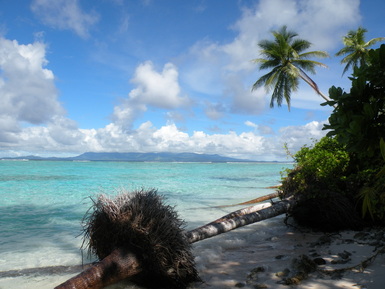 A view of Pohnpei from Ahnd Atoll I was introduced to an interesting theory this week regarding the slow pace of life in Pacific island communities. The theory states that there is a lack of urgency that pervades the culture in climates without winter, as people never have to prepare ahead for anything. Pohnpei would certainly fall into the category of being “winterless” as the daily low and high temperature for the day never vary by more than five degrees all year. Never does a Pohnpeian have to worry about being snowed in after a big storm, or plan when they want to plant and harvest their crops – every day is like the last and tomorrow will be the same. While I had read plenty about “island time” before I arrived in Pohnpei, the slow pace hasn’t really struck me until lately. Perhaps it has just been a bad week, but I have been particularly frustrated by how long everything takes. Take a normal meeting for example. A meeting that should take five to ten minutes often takes 30 minutes to an hour. People drive very slowly as well. The island speed limit is 25mph, but it’s rare to go more than a mile without someone driving between 5-10mph. Beyond just daily inconveniences there is no sense of urgency to solve any of the pressing issues present on the island. From healthcare to infrastructure, energy to education, every problem can be solved "lakkup" (i.e. tomorrow). Of course this is a generalization, but on the whole this is the culture of Pohnpei, and from what I’ve heard, all Pacific island communities. Given all of this it’s interesting to think that Pohnpeians, Micronesians, and all Pacific island communities have a lifestyle that is directly impacted by the weather. For those that don’t know, I come from a family that loves snow. No matter what the season, snowmen decorate the house. My brother still recalls the Blizzard of ’96 with childhood wonder and my father can cite snowfall records from the past century by memory. Indeed, he is legitimately a “snow expert” specializing in global snow cover. They were quite confused when I decided to live somewhere for a year where it has never snowed – ever. But I’m sure they would be overjoyed to hear that according to this one theory, which I believe holds some legitimacy, the world’s prosperity and development owes its existence to snow. As always, we have been very busy with our education program. We have a very exciting plan in store that I look forward to sharing within the next week or so. It has been a challenge to comprehensively address the great number of issues we found in the schools, but I am confident our plan will make a great difference for these students. This past weekend was a lot of fun camping on Ahnd (pronounced “Ant”). Check out some pictures of the island beauty and fishing heaven.
 My favorite shot from the weekend: a fallen palm tree being lapped by waves at dusk.
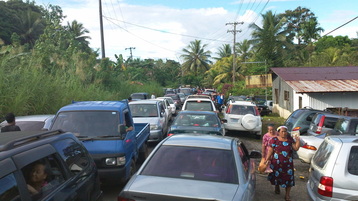 You would think that an island without a traffic light would not have traffic problems. But if you believed this, you would be wrong. This past week I was able to experience a Pohnpeian traffic jam when we drove by a funeral. Here, funerals are a big deal. They are not a few hour event with families and friends visiting. Often, funerals last a week or more, with the entire community attending. This past week there was a funeral down the road from us. A trip that usually takes 10 minutes or so took over 45 minutes, all from one 100-yard stretch of road. Another thing about Pohnpei is that there are crazy drivers everywhere and many don’t know how to park. In this case, what resulted was an already narrow road having cars parked on both sides, leaving an extremely narrow one-lane road with two lanes of traffic.
While this scene in an American city would produce a bunch of road raged maniacs honking horns and throwing certain hand gestures, everyone was pretty much calm. Sitting in the back of the MAHI pickup truck, I had a good vantage point to observe the culture. I learned previously that bringing a pig to a funeral is a major sign of respect. Thus, I wasn't too surprised to see cut up pigs on the side of the road. Though the men covered in blood holding machetes was a bit disconcerting. Women and children were walking past the cars carrying various pig parts. Seeing a little girl carrying a box with a couple of pig hooves might take some getting used to. The entire spectrum of ages was present, from children running around naked (something seen every day), to the elderly. Elections are coming up, so there likely has been politicians attending all the funerals, especially of the affluent families.
Although it might seem like a nice cultural tradition for funerals to last longer, gathering the entire community to remember someone and pay respects, there are downfalls. The largest one of these is the financial burden put upon the family hosting the funeral. For a family barely scraping for basic necessities, the costs of feeding their entire community for a week can put them in debt for years. I suppose another downfall could be the traffic!
Overall, transportation on Pohnpei deserves a post of its own. Let’s just say for now I’m glad I haven’t gotten stuck in a pothole…yet. I'll be writing soon about the progress in the education project. We have been very busy and there's a lot to report!
|





